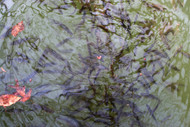What You Should Know About Different Crappie Habitats
Posted by Fish Hiding on 6th Aug 2024
Crappie, a favorite among freshwater anglers, are found across North America in diverse aquatic environments. Understanding their ecosystem and ideal conditions is crucial for successful fishing and maintaining healthy crappie populations. Here's what you need to know about crappie habitats.
Natural Habitats
Crappie thrive in various freshwater bodies, including lakes, rivers, reservoirs, and ponds. They favor environments with clear water and abundant vegetation, but flourish in stained waters as well. Aquatic plants like water lilies, cattails, and hydrillas are ideal cover for crappies, as they offer cover from predators and can harbor a rich source of food. These plants also create optimal breeding grounds, ensuring the sustainability of crappie populations and their food.
Adding Man-Made Structures
In addition to natural vegetation, man-made structures can significantly enhance a crappie habitat. Submerged structures like brush piles, artificial habitat, and fish attractors made from reclaimed PVC materials, will provide excellent cover and breeding sites. Place these structures in both shallow and deep water areas to cater to crappie throughout their seasonal movements. Crappie breed often and can take over the ponds carrying capacity quickly. Let us know your situation and we will help in any way we can.
Maintaining Water Quality
Maintaining high water quality is vital for a healthy crappie habitat. Crappie prefer water temperatures between 68 and 75 degrees Fahrenheit and a pH level between 6.5 and 8.0. Use aeration systems to improve oxygen levels, especially during hot summer months and cold winters when oxygen levels can drop significantly.
Conservation Efforts
Active conservation efforts help maintain a healthy crappie population. Control invasive plant species that can disrupt the ecosystem and compete with crappie for resources. Participate in habitat restoration projects and adhere to local fishing regulations to prevent overfishing. Practice catch and release when possible where needed, to ensure future generations of crappie can thrive.
Regularly inspect if the habitat is used to ensure it remains conducive to crappie health. Make necessary adjustments based on seasonal changes and any observed decline in the crappie population or health. Engaging with local wildlife agencies for guidance and support can also be beneficial.
If you're interested in maintaining crappie habitats and preserving this aquatic ecosystem, feel free to get in touch with Fishiding Reclaimed Artificial Fish Habitat. We look forward to providing you with more information about our selection of fish habitats!



